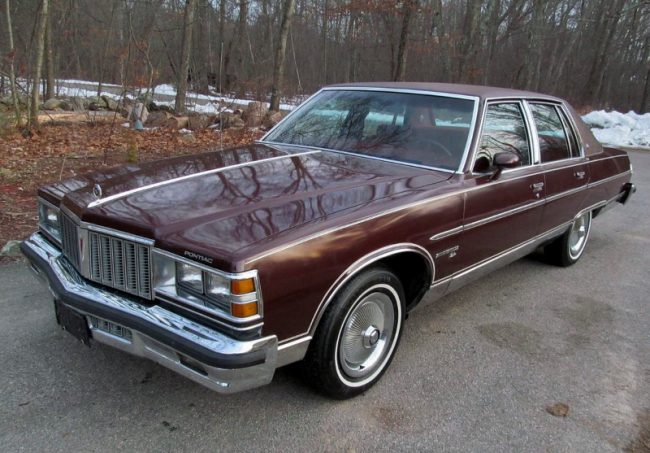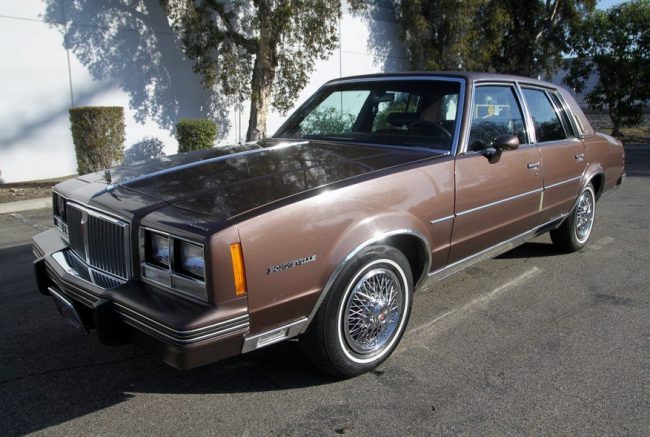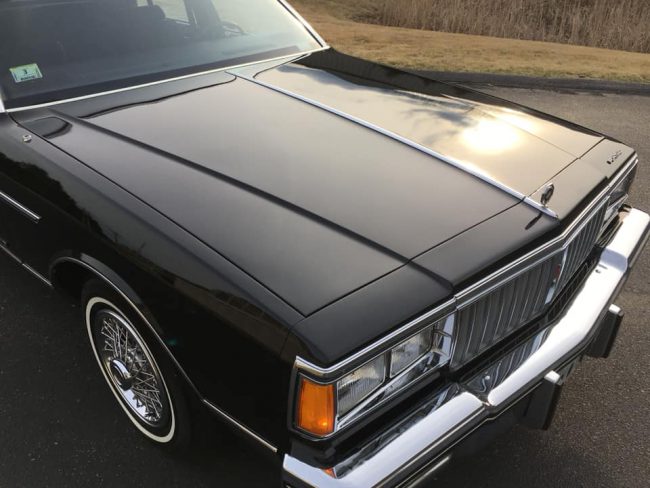
The Parisienne. The final big Pontiac. Though essentially a stopgap, they kept interest-and sales-up for those wanting something a little fancier than a Caprice Classic in the mid 1980s. So, how did the big Pontiac become a Parisienne and not a Bonneville? I’m glad you asked.

See, back in the early ’80s, the brain trust over at Pontiac Motor Division decided that full-size cars were on the way out. Historically, Pontiac had sold the least B-body cars of all the other divisions since about 1971-72, though they got a healthy bump when the fresh, downsized 1977 Bonneville, Catalina and Grand Safari appeared. But the ’74 and ’79 gas crises increased interest in smaller cars (for a while), and with sportier models like the Trans Am (aided and abetted by that ’70s classic, Smokey and the Bandit) selling at a rapid clip, it was decided that Pontiac would have a leaner, lighter model line.

And so, the midsize LeMans received a Mini-Me version of the 1980-81 Bonneville nose, got a much plusher interior, and was introduced in 1982 as the “Bonneville Model G.”

Meanwhile, in Canada, the Parisienne nameplate had been around since at least the 1960s, denoting a Dominion-built Pontiac with Chevrolet running gear. Though U.S. built Bonnevilles were generally available from Canadian dealerships as well. Thus, in 1982 you could still get a B-body Pontiac, though it was essentially a Caprice Classic except for grille, taillamps and emblems. There was even a Canada-only Parisienne coupe.

And then a funny thing happened. The giant gas shortage didn’t happen. And suddenly, folks in the States were buying big cars again. In 1983, sales of Caprice Classics, LeSabres, Delta 88s, LTD Crown Victorias and Grand Marquises all increased.

And increased further for 1984 and 1985. And Pontiac Motor Division missed out, because all the other GM divisions had kept their biggies in the lineup.

As a result, Pontiac rushed the Canadian Parisienne into the line for 1983. It didn’t appear in the full-line showroom brochures, but a separate Parisienne only brochure was rushed out, along with the car itself, a few months after the traditional new model year unveiling.

Like the Canadian version, it was basically a retrimmed Caprice, but at least they had a large car to offer. Parisienne, Parisienne Brougham (with more chrome and plusher velour interior, naturally) and Parisienne station wagons were offered.

Sales were perhaps not remarkable, but people bought them well enough for the division to pony up more cash to further differentiate them from the Caprice.

Somehow, the dies for the 1980-81 Bonneville rear quarter panels, trunk lid, taillights and rear bumper were located, dusted off, and pressed back into service.

The resulting 1985 Parisienne sedan was much more in line with the 1980-81 Bonneville. Even the ’80-’81 Brougham seats and door panels were once again available, though the Caprice instrument panel remained. The Parisienne Safari wagon carried on with no substantial changes from 1983-84.

The new car was much more impressive, with the more formal quarters and fender skirts. I liked these ’85-’86 sedans very much. Back when they were new cars, a lady at my dad’s office had one as a company car, a 1986 in gold with beige top and beige interior. I got to ride in it one time, and as I was already into domestic luxury cars even at 6-7 years old, was smitten.

Such cushy seats! Fender skirts! Hood ornament! This was quite different from the Volvo 240s my parents owned. I liked it. I liked it a lot.

As with its less-plush Caprice brethren, engine choices were the 4.3L V6 and 5.0L V8. The V6 was standard on sedans, and had 130 hp. The 305 CID V8 was optional on sedans, standard on the station wagon, and made 150-165 hp.

Parisienne sedans and wagons rode a 116-inch wheelbase, and sedans had an overall length of 212.3; wagons, 215.1.

So, the new/old Parisienne, with its more important-looking quarters, plush interior on Brougham models, and swank fender skirts was on the move, right? Wrong. Unfortunately for fans of this car (like your author) in 1987 Pontiac rationalized their line.

The old ex-LeMans Bonneville went away, replaced by the brand new H-body Bonneville, and the Parisienne was discontinued.

1986 Parisienne production came to approximately 85,000 units: 27,078 sedans, 43,540 Brougham sedans and 14,464 Safari station wagons. Parisienne Broughams like our featured car had an MSRP of $11,949.

The Parisienne wagon remained in the line, but was renamed simply, “Safari.” It would last through the 1989 model year.

I always wondered why it was killed off. The Caprice lasted all the way to 1990, and sold well in its essentially 1980 form to the end, but then they had taxi and police sales.

The tooling was long amortized, so I have frequently wondered over the years why they didn’t just continue it to ’90 like the Caprice. Even if sales went down, each sale would be essentially pure profit, due to the age of the design. Oh well.

Today’s featured car is owned (for now) by my friend Anthony Gozzo. He runs a vintage car dealer, Specialty Motor Cars, and his inventory is heavy on Broughams, so of course I’m always interested in seeing new arrivals.

Such as this beautiful Parisienne Brougham. Really, is there a better color combination than black with a red or burgundy interior?

As Anthony related, this final year Parisienne Brougham is a “One owner car that was just acquired from the 86 year old owner. Garaged in the same bay since it was new.” It has only 67,000 miles on the clock. He had it available for $7995.

But between then and this article going to press, it’s since sold. Whoever got it, got a good one! Those GM B-bodys, no matter which model, are robust, comfortable cruisers, even today. And if anyone makes a diecast model of a 1985-86 Parisienne Brougham sedan, your author will be buying one in a heartbeat.








9 Comments
Always wondered what was the story on those cars. I knew what the Canuk Parisianne was; but I couldn’t see the Wide-Track people bringing over, straight from Ontario, a Pontolet. Now, at least I can see how the badge-engineering the intermediate into a Bonneville kind of tipped their hands…but since they were using parts of the old American Bonneville stamping in the end, why did they not go the whole way and Bonneville-ize the Canadian model, before shipping it over? The name…sure, they were boxed. But nothing screams Badge-Engineering like using another model’s dash and instrument lineup. The old Bonneville interior was done, the tooling existed – let the Canadians have it, and have real Pontiacs for a change, for awhile.
Mistakes like that are why Pontiac is gone and GM is a zombie recreation.
Can you imagine the number of meetings that resulted in this cul de sac? “OK, let’s get rid of the Bonneville…no, wait, let’s just move it to the intermediate platform and puff it up a little.” “Wait, big cars are back, let’s bring back the Bonneville…wait, we can’t, so bring in the Parisienne”. So, all that money to degrade/eliminate the best known model they had. Did they learn nothing from the Grandville?
It was one of those tail wagging the dog situations that dealers pushed on the divisions sometimes, really big cars like the Parisienne were dead, and really had no business being in a line up with cars like the Trans Am, Fiero and 6000 STE, but dealers still wanted a “big car” even though it was a shrinking dead market, the pushing back of the downsized FWD big cars to 1986 didn’t help either, even the RWD G-body Bonneville should have been canned.
Carmine,
Even so, why not call the G the Grandville and…well, I guess they needed the Bonneville name to bestow credibility to the Le Mans, but it really left Pontiac without any historical credibility when big cars came around again. They could have used it!
Man, that takes me back. I’m not “old” by any means (45 rotations and counting) but the first car I bought with my own money was a 1980 Pontiac Parisienne. It had a 182,000km (110k miles) on it when I bought it for $700 in 1993. It was painted gold/brown with a tan interior, and had the broad bar speedo, which was never accurate (up to 30km/h off!) and the classic 305 V8. Wind-up windows. By the time it left me, it had a clarion CD deck, Grateful Dead stickers in the back window, and 427,000km (265k miles) on the clock via multiple roll-overs of that 5 digit odometer in my ownership. I may also have painted it black with a roller and household exterior paint. Don’t ask.
Obviously, I followed that with a lackluster ’86 Firebird. I then went back to the fold with an ’88 Pontiac Parisienne Safari wagon – seating for 8 (legally, at least), and room for a queensize mattress with the seats folded down (hey, I was still in university, and it was easier to plan to stay at the party). That one was maroon with a maroon interior, power locks and windows (LUXURY!) and that glorious bi-mode wagon door, with power glass. The downside was the Olds 307 V8, which shared parts with almost nothing, if I remember correctly.
That was followed by an ’86 Parisienne Safari Wagon, but in blue, with faux wood trim, and a tan interior, but the same power accessories and loathed Olds 307.
I miss ’em all, to this day, they all served me extremely well, made glorious sounds from the 4-barrel carbs, and got terrible mileage and worse acceleration. I still miss that gunsight Pontiac emblem on the hood, and I’d have one again, wagon or sedan, in a second, as long as I had somewhere to park it, and something that got better than single digit MPG’s for daily use.
Interesting this idea that because for 87 there was a modern younger aiming front drive Bonneville, there shouldn’t be a profitable, still fairly high volume big traditional model in the line up. I doubt there would have been many cases of cross shopping between the two models causing cannibalization of sales of the newer model. I think it comes out of the Chuck Jordan style thinking that walking by a traditional model on the way to the new one will turn the prospective buyer off. He was probably right in that people who only considered imports turned the nose up to cars like the Parisienne. The fact is though that Pontiac had no shot with those people no matter what they built. The STE and the Bonneville had the younger family/salary man well covered with good performing, high quality, roomy vehicles. There was no reason to let the lineup to be denuded of tradition. The kind of mistake you get from a Chuck Jordan or Chris Bangle or whoever the line of nameless drones who managed to sink Honda post 1995. Not a mistake made by real leaders like Ribicki, Iacocca, and Lord Stokes who know who they are and who they are working for.
There was no need, sometimes you just need to say NO to a division, a Parisienne had no place in an post 1984 Pontiac line up like a Torpedo Sedan with a flathead 8 would have no place in a line up with GTOs , 2+2’s and Firebirds.
If you want a Delta 88 or a LeSabre, go buy one with an Oldsmobile or Buick badge.
I didn’t appreciate these cars very much when they were new. Maybe because in the motor pool of the company I worked for at the time had a lot of Impalas and Caprices, but this looked far too much like a Chevy with Pontiac mascara. My wife was a sous chef at the time and found the Parisienne name amusing, as it is a style of cooked potato…
Regardless, the car would have had a fair amount of upscale flair, compared to a Cappy, in the Brougham fashion. Although, that fashion was starting to fade, it was probably a good bet to revive the Pontiac B body and garner a few sales from it. No one really knew exactly how the new H bodies would be received and this would also satisfy the traditionalists who wanted a big, RWD Pontiac sedan and wagon.
If I’m quite honest, I really don’t feel any love for this car. I much prefer the actual 77-79 Pontiac that proceeded it.
The Parisienne debuted in Canada in 1958 at the top model in the Laurentian series, equivalent to the Chevy “Bel Air Impala” and sharing the same roof. Like the Impala, it became a full series of its own for 1959.